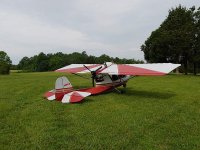Hi Jack,
If you'd care to visit the first link posted in Motormouse's first post, and download a copy of
AirEd V1.52, I'll describe what I think you may need to edit. ( There's an updated ini file also.....DON'T bother with it for now. Just for this exercise, it's not needed.)
Looking at the photo you've posted of the Challenger, one can see it's got plain ailerons and a narrow, wasp-like waist, pusher prop and engine amidship. I'll bet if you're cruising a straight line and initiate a roll with only ailerons, the nose will yaw opposite the roll, and she will slowly side slip into an uncoordinated turn, loosing speed and altitude at the same time.
Am I right...?
Okay.
Any adjustments you've made to the rudder & aileron inputs in the aircraft.cfg scalars, return them to original values. (1.0?)
Unzip AirEd, open the program, go up to "file" and left click on that, then as the menu drops down, left click on "open". A window will open, and if it's the first time you've used AirEd, you'll need to browse all the way to the sim, and right to your Challenger model until you see the air.file, and then open that.
Now you're looking at the real blood and guts of the thing.
Scroll down to section
1101 Primary Aerodynamics. Left click on the header and that section will open up for you.
Scroll down and pay attention to these following entries:
*Cn_beta Yaw Moment - Sideslip (Weathervane Stab)=
----and----
*!Cn_da?Yaw Moment - Aileron?=
>>>For the (Weathervane Stab) entry, the higher the number, the greater the model's quality to simply turn (or weathervane) into a roll. Reduce the number, and it will resist. ( The Challenger will resist, so look at lowering the existing number.)
>>>For Yaw Moment - Aileron, it's a negative number. For instance, the unmodified AI Piper PA-28 in my sim shows the value of -13.
At that level, an aileron roll would be very clean, without any adverse yaw. Crank that value up to -200, and you'll see some real difference. (Maybe too much...)
These two entries are not so sensitive, so you can really lay on the numbers to create a noticeable effect.
Also, scroll that section back up just a bit and check
*Cl_da Roll Moment - Rudder= ....and ensure that it has a negative value....-10, -25, whatever. This will ensure that your rudder input will roll the plane in the correct direction. (inboard the yaw)
I frequently find models that refuse to roll with rudder input and find that entry created with a positive value instead of negative.
Also make sure that you back up the original file before you start carving it up.
How this helps make the Challenger more accurately challenging.....




